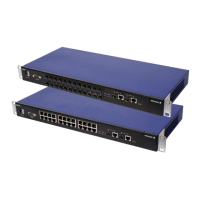IndexIndex
QoS is best effort, in other words, with the lowest of each QoS parameter.
However, where an End-user with the same service is configured in the other
EFN Ethernet access switches, the QoS parameters for that service are used.
6.1.3 Stand-alone Rapid Spanning Tree
The stand-alone daisy chained requirements also apply to stand-alone rapid
spanning tree. After entering the stand-alone daisy chained CLI commands,
enter the following commands in each EFN to configure Rapid Spanning Tree:
add rapid_spanning_tree 1 ports ethernet_port 25
add rapid_spanning_tree 1 ports ethernet_port 26
In the CLI commands above, 1 is used for the instance ID for the RSTP. The
same value is used for all the uplink ports on all the EFN Ethernet access
switches in the Rapid Spanning Tree.
In addition, see section 9.1 on page 72 for information on using Rapid
Spanning Tree.
6.2 Embedded Topologies
EFN324 may also be used as an embedded node. In other words, the
EFN324 is part of an Ethernet Access Node (EAN) and is managed via an
ECN, instead of directly by PEM.
The following basic requirements apply to every embedded EFN324:
To be recognized as an embedded node, the EFN324 must be configured
as a flexible block, with a Switch ID number. In addition, the EFN324 must
obtain its IP address using DHCP, and the management VLAN must be
configured in switching domain 1.
The EFN324 Ethernet access switch(s) uplink must be connected to a
Gigabit port. If the EFN is connected directly to an ECN330, this means
that only ECN330 uplink ports may be used. However, if the EFN is
connected directly to an ECN430, any port may be used.
Figure 24 on page 51 illustrates the use of the EFN324 as an embedded node.
Note that the EFN324 Ethernet access switches can be connected directly to
the ECN330 or ECN430 and do not have to be connected via an unmanaged
network.

